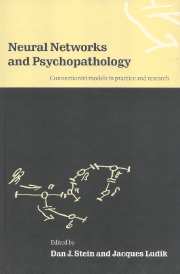Book contents
- Frontmatter
- Contents
- List of contributors
- Preface
- Part one General Concepts
- Part two Clinical disorders
- 7 The nature of delusions: a hierarchical neural network approach
- 8 ‘Produced by either God or Satan’: neural network approaches to delusional thinking
- 9 Neural network modelling of cognitive disinhibition and neurotransmitter dysfunction in obsessive–compulsive disorder
- 10 The fables of Lucy R.: association and dissociation in neural networks
- 11 Neural network analysis of learning in autism
- 12 Are there common neural mechanisms for learning, epilepsy, and Alzheimer's disease?
- Epilogue
- Index
11 - Neural network analysis of learning in autism
from Part two - Clinical disorders
Published online by Cambridge University Press: 12 January 2010
- Frontmatter
- Contents
- List of contributors
- Preface
- Part one General Concepts
- Part two Clinical disorders
- 7 The nature of delusions: a hierarchical neural network approach
- 8 ‘Produced by either God or Satan’: neural network approaches to delusional thinking
- 9 Neural network modelling of cognitive disinhibition and neurotransmitter dysfunction in obsessive–compulsive disorder
- 10 The fables of Lucy R.: association and dissociation in neural networks
- 11 Neural network analysis of learning in autism
- 12 Are there common neural mechanisms for learning, epilepsy, and Alzheimer's disease?
- Epilogue
- Index
Summary
Goldilocks … dipped a spoon into Father Bear's bowl, but the porridge in it was too hot… Then she tried some from Mother Bear's bowl, but that was too cold. The porridge in Baby Bear's bowl was just right…
Robert Southey, Goldilocks and the Three Bears
Even though autism is a relatively infrequent disorder, occurring in about 1.5 to 2 cases/1000 in the population (Sugiyama and Abe, 1989), it has attracted the attention of many researchers since the time of Kanner's (1943) initial description of the syndrome. This curiosity reflects, in part, the fact that the bizarre and puzzling behaviors shown by individuals with autism present a challenge to theorists. More urgently, the fact that age-appropriate learning and social–communicative behavior is not present in these children has a devastating impact on their families and on the children's later social, emotional and cognitive development. Understanding the biological mechanisms responsible for autism may help to shed light on the best way to treat this syndrome.
Autism has an age of onset that is, typically, between 12 and 30 months of age, although some mothers report noticing abnormalities in their child's behavior from birth. The first behavioral disturbances noted include lack of response to the child's name being called, acting as if deaf, despite other evidence of apparent normal hearing (e.g., dashing to the kitchen from another room when a candy bar is unwrapped); failure to anticipate being picked up; failure to cuddle when held; poor eye contact and lack of interest in social interaction; failure to use normal gestures such as pointing to communicate (instead pulling others to desired objects);
- Type
- Chapter
- Information
- Neural Networks and PsychopathologyConnectionist Models in Practice and Research, pp. 274 - 315Publisher: Cambridge University PressPrint publication year: 1998
- 13
- Cited by

